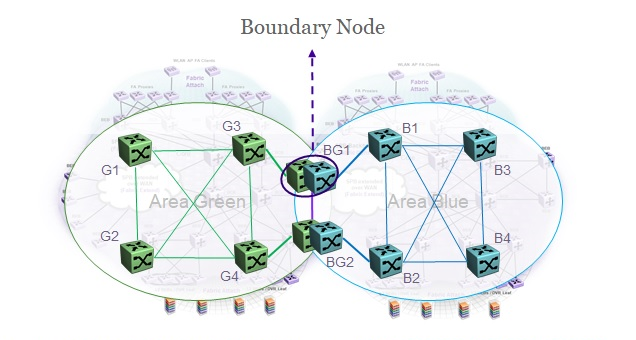Multi-area SPB
|
Feature |
Product |
Release introduced |
|---|---|---|
|
Multi-area SPB Boundary Node |
5420 Series |
Not Supported |
|
5520 Series |
Not Supported |
|
|
VSP 4450 Series |
Not Supported |
|
|
VSP 4900 Series |
Not Supported |
|
|
VSP 7200 Series |
Not Supported |
|
|
VSP 7400 Series |
VOSS 8.4 |
|
|
VSP 8200 Series |
Not Supported |
|
|
VSP 8400 Series |
Not Supported |
|
|
VSP 8600 Series |
Not Supported |
|
|
XA1400 Series |
Not Supported |
The Multi-area SPB feature enables building a scalable Shortest Path Bridging (SPB) network, consisting of multiple Intermediate System-to-Intermediate System (IS-IS) areas that connect to each other through the boundary nodes. The Multi-area SPB feature provides flexible network design through which you can group the nodes in the areas on a need basis.
Each area in the Multi-area SPB network contains the interior nodes and the boundary nodes.

Each boundary node runs two Intermediate-System-to-Intermediate-System (IS-IS) instances, representing the home area and the remote area. Each IS-IS instance runs the Shortest Path First (SFP) computation and uses its own Link State Database (LSDB). The boundary nodes support Backbone Edge Bridge (BEB) functionality in addition to the Backbone Control Bridge (BCB) configuration and the UNIs belong only to the home area. You can configure IS-IS interfaces on each instance.

Note
The boundary nodes do not support Auto-sense, you must manually configure all network-to-network interfaces (NNI) on the boundary nodes.
The multiple areas in the Multi-area SPB network connect in various patterns, for example, the hub and spoke topology and the daisy chain topology.
Designated and Non-designated Boundary Nodes
Among the boundary nodes in the Multi-area SPB network, the system elects the designated boundary node on basis of the unique chassis MAC value of the node. The nodes in the SPB area advertise their chassis MAC value using the link state packet (LSP) and the system elects the node with the smallest chassis MAC value as the designated boundary node. Each node in the network detects the designated boundary node on basis of the LSDB information.
The functions of the boundary nodes in the Multi-area SPB network are:
- Designated boundary node:
- Creates the area virtual node LSPs on each IS-IS instance.
- Configures the virtual node's adjacency with the other boundary node on basis of the reachability of the node.
- Advertises the services on the area virtual node on basis of the redistribution policies that you configure.
- Non-designated boundary node:
- Connects to the area virtual node and the system uses it to forward the traffic on basis of the IS-IS computation.
- Takes over as the designated boundary node if the designated boundary node is no longer available in any area.
For more information about the area virtual node, see Area Virtual Node.
Minimum Requirements
The minimum requirements for the Multi-area SPB to function are:
-
Two boundary nodes to provide redundancy.
-
Multi-area SPB redistribution policies between areas, like layer 2 redistribution, layer 3 unicast redistribution, multicast redistribution, Distributed Virtual Routing (DvR) backbone redistribution and so on. For more information, see Multi-area SPB Redistribution and Policies.

